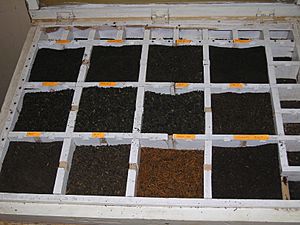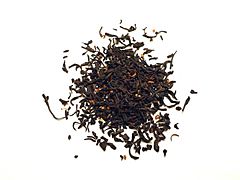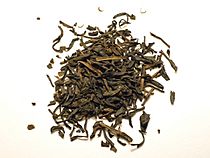Tea blending and additives facts for kids
Tea blending is the blending of different teas together to produce a final product. This occurs chiefly with black tea that is blended to make most tea bags but can also occur with such teas as Pu-erh, where leaves are blended from different regions before being compressed. The aim of blending is to create a well-balanced flavour using different origins and characters. This also allows for variations in tea leaf quality and differences from season to season to be smoothed out. The one golden rule of blending is this: Every blend must taste the same as the previous one, so a consumer will not be able to detect a difference in flavour from one purchase to the next.
There are three main reasons for tea blending:
- Commercial tea blending is a way of ensuring consistency of batch on a mass scale.
- Blending tea leaves with herbs and spices for the purpose of holistic health has a rich history in both Chinese and Indian cultures.
- Blending, scenting or flavouring teas is a popular way of adding interesting and more complex flavour notes.
There are various teas which have additives or different processing than "pure" varieties. Tea is able to easily receive any aroma, which may cause problems in processing, transportation or storage of tea, but can be also advantageously used to prepare scented teas. Tea can be flavoured in large blending drums with perfumes, flavourants, or essential oils added. Although blending and scenting teas can add an additional dimension to tea, the process may also sometimes be used to cover and obscure the quality of sub-standard teas.
Flavoured and scented teas
Although many teas are still flavoured directly with flowers, herbs, spices, or even smoke, teas with more specialized flavours are produced through the addition of flavourants or perfumes. This is particularly true for tea blends with pronounced fruit or flower aromas, which cannot be achieved with the original ingredients. Some firms such as Mariage Frères and Kusmi Tea have become quite famous for their perfumed teas. The most commonly used scents are jasmine, traditionally used to scent delicate white and green teas, and bergamot oil, which is used to scent Earl Grey tea.
Due to the number of scents that can be produced by the mentioned artificial methods, the section will concentrate on teas flavoured directly with the original scent materials.
Flowers
A variety of flowers are used to flavour teas. Although flowers are used to scent teas directly, most flower-scented teas on the market use perfumes and aromas to augment or replace the use of flowers. The most popular of these teas include the flowers of the following:
- Jasmine: Spread with jasmine flowers while oxidizing, and occasionally some are left in the tea as a decoration. Jasmine is most commonly used to flavour green teas to produce jasmine tea, although sometimes it is used to flavour light oolong teas such as baozhong tea
- Osmanthus: In China, osmanthus tea (called guì huā chá, 桂花茶) is produced by combining dried sweet osmanthus (Osmanthus fragrans) flowers (guì huā, 桂花) with black or green tea leaves in much the same manner the more familiar jasmine tea combines jasmine flowers with tea leaves. The flowers are spread while oxidizing, and occasionally some are left in the tea as a decoration. This flower gives the tea a mild peach flavour. It is the second most popular scented tea (after jasmine) in China.
- Rose: Spread with rose flowers while oxidizing, occasionally some are left in the tea as a decoration. In China, roses are usually used to scent black tea and the resulting tea is called rose congou.
- Chrysanthemum: The flowers are often brewed alone as a chrysanthemum tisane, but it is also commonly mixed with pu-erh tea to make chrysanthemum pu-erh.
- Lotus: Vietnamese lotus tea is made by stuffing green tea leaves into the blossom of Nelumbo nucifera and allowing the scent to be absorbed overnight. Another common technique for making this tea is by jarring or baking the tea leaves with the fragrant stamens of the flower multiple times.
- Orchid: Including vanilla.
Herbs
- Mint: Maghrebi mint tea, or Moroccan mint tea, consists of a mixture of green teas and any variety of the mint plants (known as nana), and is popular in the Middle East and desert areas of North Africa. See also Peppermint tea.
- Pandan: Pandan, also known as screwpine, is a popular additive to green or black tea in Malaysia, Indonesia, and the Philippines.
Other flavourants
- Citrus peel: The best known of this class is Earl Grey, which is made by infusing black teas with citrus or bergamot peel. More typically, however, an essential oil or perfume blend of the citrus fruit is used. Lady Grey differs from Earl Grey in that it contains additional lemon peel and orange peel.
- Rum: Jagertee is a tea with rum added.
- Roasted grain: Genmaicha, a Japanese tea with roasted rice added to green tea, is flavoured by adherents of a macrobiotic diet. Wheat and barley are also used to blend with tea.
- Smoke: One type in this class is lapsang souchong, which is produced by drying black tea over smoking pine needles, which produces a striking smoky odor and flavour. The best varieties are not overwhelmed by the smoke, but retain subtlety and a mix of other flavours. Lapsang souchong is found in many Russian Caravan blends.
- Spice: Tea such as Indian and Middle Eastern masala chai, flavoured with sweet spices such as ginger, cardamom, cinnamon, cassia, black pepper, clove, anise, fennel, Indian bay leaf and sometimes vanilla, nutmeg and mace. See also Kahwah.
- Tapioca: Taiwanese bubble tea is flavoured with chewy tapioca balls (or "boba").
See also
 In Spanish: Blend de té para niños
In Spanish: Blend de té para niños




